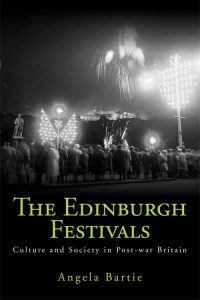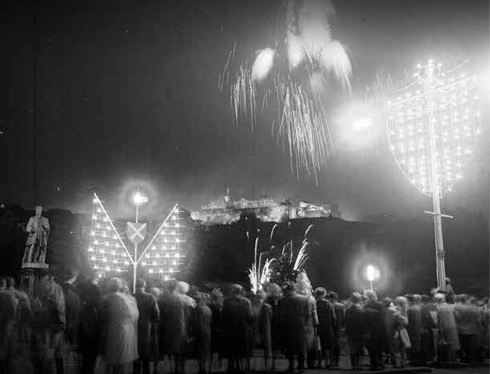
An extract from The Edinburgh Festivals: Culture and Society in Post-war Britain by Angela Bartie
On Sunday 24 August 1947, the first Edinburgh International Festival of Music and Drama opened with a service of praise in St Giles’ Cathedral, the Mother Kirk of Scottish Presbyterianism. Present at this ‘civic service of inauguration’ were members of the local authority, Edinburgh Corporation, dressed in their ermine-trimmed robes, ministers of the Church of Scotland, members of the Episcopal and Free churches, civic leaders from around Scotland, representatives of law, medicine and the arts, and all ‘distinguished visitors known to be in the City at that time’.1

This ceremony officially opened the new festival with hymns, prayers and a blessing, as well as what a critic for The Times described as music of the English Renaissance (Hubert Parry’s I Was Glad, normally used in royal coronations, and Ralph Vaughan Williams’s Te Deum). This, he wrote, ‘matched in sound the ocular splendour of official uniforms and academic robes’.2 The inaugural opening concert was performed by L’Orchestre des Concerts Colonne, while the full programme served up a rich feast of European high culture: the Halle´, Jacques, Liverpool Philharmonic and BBC Scottish orchestras were all represented; there was chamber music, morning concerts, recitals of Scottish song, and the Glyndebourne Opera presenting Macbeth and Le nozze di Figaro. Sadler’s Wells Ballet presented The Sleeping Beauty, and drama lovers could see the Old Vic doing The Taming of the Shrew and Richard II as well as La Compagnie Jouvet de The´aˆtre de L’Athe´ne´e performing L’E´ cole des femmes and Giraudoux.3 A highlight of the inaugural event was the reunion of the Austrian composer Bruno Walter (who had been forced to emigrate, first to France and then to the United States, after the Nazi Anschluss of Austria in 1938) with the Vienna Philharmonic Orchestra. The singer Kathleen Ferrier recalled:
It was unforgettable. The sun shone, the station was decked with flags, the streets were gay. Plays and ballet by the finest artists were being performed, literally morning, noon and night, and hospitality was showered upon guests and visitors by the so-called ‘dour’ Scots! What a misnomer!4
Stereotypes of ‘dour’ Scots abounded in Lionel Birch’s report for Picture Post. On arriving and seeing the ‘brave but stingy’ bunting on the roof of Waverley railway station, he wondered whether the whole Festival ‘wasn’t going to be a bit like that – brave but stingy’. How, he asked, were Edinburgh citizens going to react to ‘this cultural and cosmopolitan invasion’ in the ‘land of the dour, reticent, wind-bitten Scottish’? Every night after the opera, he reported, ‘the Princes Street trams were crammed with white ties and fur coats (mink, opossum and Scotch rarebit) and with long dresses tripping each other on the winding stair to the top deck’, with the Scots much in evidence, enjoying themselves ‘every bit as openly as the French or the Swedes’ (despite having been told ‘for centuries’ that ‘to enjoy oneself is probably a Bad thing’). Ultimately, Birch told his readers, Edinburgh citizens made the Festival:
At least for the duration of the Festival, the tetchiness and ungenerosity [sic] which have disfigured post-war Britain were wiped away. In their place was a fresh spirit – the Festival spirit, or the Christian spirit, or the divine spirit, or the human spirit, or whatever you like to call it. People treating all other people with consideration, and indeed (I have to say it) with love, all through the day. Commonplace, d’you think? No, chum; revolutionary.”5
When it began in 1947, the Edinburgh International Festival of Music and Drama encapsulated many of the new values given to culture in the immediate post-war world: a means of spiritual refreshment, a way of reasserting moral values, of rebuilding relationships between nations, of shoring up European civilisation and of providing ‘welfare’ in its broadest sense. Culture was also viewed as a useful new economic tool in the burgeoning tourist industry (the Scottish Tourist Board was founded in 1946) and as a means of attracting dollars into the beleaguered British economy. The Edinburgh International Festival was underpinned by ‘high culture’, and aimed to present the very best in music and drama performed by the very best artists the world had to offer. However, there was contest over ‘culture’ in Edinburgh, embodied most obviously in the activities of the Edinburgh Festival Fringe, which also began in 1947, and in wider cultural developments that influenced and affected the Fringe. From the mid-1950s, and particularly during the 1960s, tensions over the meaning and purpose of ‘culture’ and ‘art’ were to multiply and intensify across the western world, and these can be seen played out in microcosm in Edinburgh, the ‘Festival City’. It has been argued that the very definition of the word ‘culture’ was the fundamental issue in the post-war critical debate.6
The Festival City provides an effective lens through which to explore critical debates over culture in the post-war world, changing practices in the arts, and broader social change between 1945 and 1970. We can trace the rise of the festivals as sites of controversy, notably in relation to the cultural debate on liberalisation in British society and to the challenges to dominant ideas about art that arose across the western world during the 1960s. As the site of a major international festival, Edinburgh had a clear importance in the arts during that period – an importance that has so far been neglected by cultural historians. We will focus mainly on the dramatic arts at the Edinburgh International Festival of Music and Drama and at the ‘fringe’ that grew up around it, as well as in other important theatres in Edinburgh, namely the Church of Scotland-owned Gateway Theatre, the independent Traverse Theatre Club and the civic-run Lyceum Theatre. Collectively, the Edinburgh festivals form a crucial – and curiously overlooked – site for the historian of cultural change in post-war Britain.
For too long, Edinburgh has been marginalised, ignored or glossed over in cultural histories of post-war Britain. Even when Edinburgh is cited in relation to the arts in society or the cultural upheavals of the 1960s, it is largely seen as marginal. It is often seen as peripheral in histories of modern Scotland too, viewed more as an annual ‘invasion’ of outsiders than as a vital part of national cultural history. When scholars have explored the arts in post-war Britain and the cultural revolution of the 1960s, they have tended to draw attention to London and the metropolitan arts.7 But it is important to highlight the insights that the Festival City can give us into social and cultural change in post-war Britain: the growing influence of the arts in society, the way that youth had come to dominate the arts by the 1960s, and how ‘high culture’ was challenged and an emphasis on wider participation in culture popularised during the second half of the twentieth century. The Edinburgh festivals reveal, too, how cultural change was intimately linked to broader social change. Experimentation in the arts resulted in new artistic forms and challenges to censorship and traditional values. High-profile controversies on the Edinburgh stage, including that over the naked model wheeled across the gallery of the University of Edinburgh-owned McEwan Hall in 1963, created concern among ministers of the Church of Scotland, Conservative councillors on Edinburgh Corporation, and others both within and outside Scotland. An important thread running through this book concerns the relationship between the arts and organised religion. By exploring this changing relationship across a period in which the status of churches in society declined at the same time as culture was elevated in importance, new insights into the liberalisation of the arts from moral austerity and secularisation can be revealed.
The Edinburgh festivals can also tell us much about the changing role of culture in post-war Britain, cultural policy and public funding of the arts, theatre history and theatrical censorship, and the growth of experimental and community arts. They are significant, too, in the emergence of Scottish culture and society from a long Presbyterian history. There is a pressing need to integrate the Edinburgh festivals into our understanding of how the new Scotland developed, casting off the shadow of John Knox and finding a new cultural confidence that paved the way for debates over devolution and Scottish independence.8 By bringing artists and performers from all over the world to Edinburgh for three weeks every year, this brave post-war initiative was to have a far-reaching influence not only on the arts in Scotland but on the very character of modern Scotland.

Angela Bartie is Senior Lecturer in Scottish History at the University of Edinburgh. Find out more about her book The Edinburgh Festivals
NOTES:
1. The Times, 25 August 1947; Edinburgh City Archives (hereafter ECA), Early Festival Papers, Festival Notes, 8 October 1946.
2. The Times, 25 August 1947. 3. The full programme for this (and every subsequent Festival up to and including 1996) can be found in Miller, The Edinburgh International Festival, Appendices.
4. Kathleen Ferrier cited in Miller, The Edinburgh International Festival, 31.
5. Birch, ‘Edinburgh’s Festival’.
6. Hewison, Culture and Consensus, 34. See also Dworkin, Cultural Marxism in Postwar Britain; Sinfield, Literature, Politics and Culture in Postwar Britain.
7. For perspectives on Scotland, see McArthur, Scotland, CEMA, and the Arts Council; Galloway & Jones, ‘The Scottish Dimension of British Arts Government’. For the north-east of England, see Vall, Cultural Region; for Wales, Jones, ‘An Art of Our Own’.
8. Surveying the historiography, it often seems that the Festival is the proverbial ‘elephant in the room’, mentioned only in passing (if at all). See e.g. MacDonald, Whaur Extremes Meet; Cameron, Impaled upon a Thistle.





